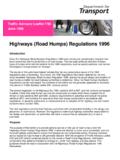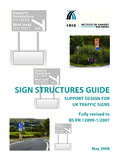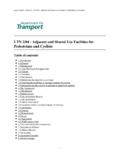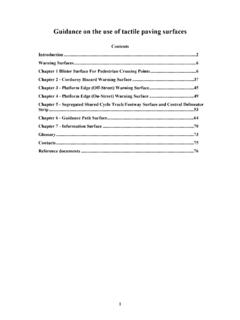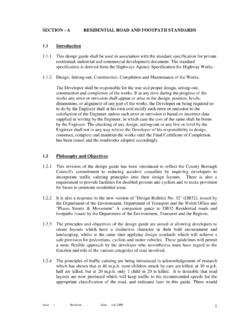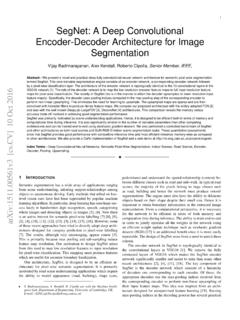Transcription of Department for Transport - LTN 1/04 - Policy, Planning and ...
1 LTN 1/04 - Policy, Planning and Design for Walking and CyclingTable of contents1. Introduction Context 2. Policy Walking, cycling and integrated Transport Walking, cycling, health and the environment Walking, cycling and road safety Strategies for encouraging walking and cycling Monitoring and re-evaluation 3. Planning and Design principles Introduction Design requirements Hierarchy of users The design pedestrian and design cyclist Route function and journey purpose Hierarchies of provision Cycling infrastructure for different traffic speeds and volumes Infrastructure Planning Audit and review Land use Planning Consultation and publicity 4.
2 Applying The Design Options Introduction Traffic reduction Speed reduction Reallocation of road space to pedestrians Provision of at-grade crossings for pedestrians Improved pedestrian routes on existing desire lines New pedestrian-only alignment or grade separation Complementary and trip-end facilities for pedestrians - 1 - Department for Transport - LTN 1/04 - Policy, Planning and Design for Walking and Junction treatment, hazard site treatment and traffic management for cyclists Redistribution of the carriageway for cyclists Cycle lanes Cycle tracks Complementary and trip-end facilities for cyclists Temporary measures for pedestrians and cyclists 5.
3 Key References and Useful Addresses General Walking Cycling Walking and cycling Transport , health and environment Road safety Useful addresses Annex A 1. Introduction Context The Government's policy for integrated Transport has introduced a substantial change in theapproach to Transport schemes. In promoting an integrated Transport system, the Government recognisesthe necessity for improving conditions for pedestrians and cyclists, with particular emphasis on the needsof disabled people. Promotion of walking and cycling is important in helping to support other majorGovernment objectives such as improved public health, better air quality, and sustainable land-useplanning.
4 This Local Transport Note LTN applies to rights of way under the control of local highwayauthorities. Two other LTNs accompany it. LTN 2/04 Adjacent and Shared Use Facilities for Pedestriansand Cyclists provides updated guidance on the application and design of off-carriageway facilities forcyclists and pedestrians supersedes LTN 2/86 . LTN 3/04, Signs and Markings for Cycle Routes providesguidance to designers of cycling facilities on the use of Traffic Signs Regulations and General Directions, 2002 and it includes some common layouts supersedes LTN 2/87.
5 All three LTNs refer to parts of the Design Manual for Roads and Bridges DMRB . However, whilethe DMRB is a useful source of standards and advice for trunk roads, it is often not appropriate in thecontext of local roads. Local authorities should therefore consider how it is applied with care. Ultimately,local authorities are the arbiters of what happens on local roads. Guidance for accommodatingnon-motorised users along and across trunk roads is available from the Highways Agency. Developments and innovations for walking and cycling are reported in Traffic Advisory Leaflets TALs available from the Department for Transport DfT.
6 - 2 - Department for Transport - LTN 1/04 - Policy, Planning and Design for Walking and This document sets out the policy context that supports the promotion of pedestrian and cyclingfacilities Chapter 2 . It also describes common design principles for pedestrian and cycle provision Chapter 3 . These include: an overarching principle that any new measures proposed for pedestrians and cyclists shouldrepresent a real improvement over the existing situation, particularly in terms of accessibility, and,where practical and appropriate, offer users a positive advantage over motor traffic; the role of land use Planning in enabling users to undertake more journeys on foot or by cycling.
7 A hierarchy of users, which can assist in prioritising the needs of different Transport modes wherethere are conflicting demands on carriageway space, or there is incompatibility in the highwaylayouts suiting different modes; hierarchies of provision, which provide a systematic approach to determining the best engineeringsolution for pedestrians and cyclists at a particular site; minimum requirements which should be met if the infrastructure is to be Convenient, Accessible,Safe, Comfortable and Attractive for pedestrians and cyclists; the various needs of different "design cyclists" and "design pedestrians" which should be consideredwhen Planning appropriate infrastructure; and the need for monitoring and evaluation to ensure that measures are fulfilling their intended purpose.
8 The decision-making framework for selecting and designing pedestrian and cycle infrastructurecovers network Planning , cycle/pedestrian review, scheme selection, scheme design and audit, and schemeimplementation. The selection process uses the hierarchies of provision, and guides the designer toconsider traffic reduction and speed reduction as the first options, followed by various on-carriagewaysolutions for cyclists. Where routes follow existing roads, the designer should only consider newoff-carriageway options for cyclists or new alignments/grade-separated facilities for pedestrians if allon-carriageway solutions including traffic and speed reduction have been rejected as insufficient orinappropriate.
9 However, this does not necessarily apply where the intention is to improve an existingoff-carriageway route or where there is a specific need for a new route away from the road. LTN 2/04gives guidance on the introduction of off-carriageway routes for cyclists. Chapter 4 of this LTN outlines in more detail the infrastructure techniques available to cater forwalking and cycling, and provides references for further guidance on these techniques. Examples areprovided of how the policy and principles of the design process might be applied to promote walking andcycling.
10 2. Policy Walking, cycling and integrated Transport The need to provide for pedestrians and cyclists is emphasised in the Government's Guidance onFull Local Transport Plans and in Transport 2010 - The 10 Year Plan in which the delivery mechanismsfor the Transport White Paper are outlined. These documents emphasise the key role of walking andcycling as the main modes used for short trips especially to local facilities such as shops, schools, etc and in providing access to public Transport for longer journeys. - 3 - Department for Transport - LTN 1/04 - Policy, Planning and Design for Walking and The role of walking and cycling in helping to create liveable towns and cities and to promote healthimprovement and social inclusion has not always been recognised in the past.


